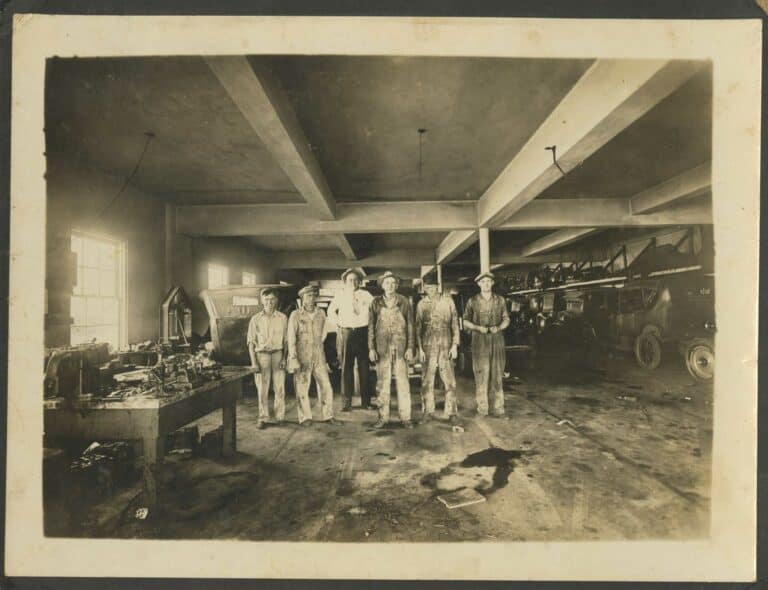I love this photo of my grandfather (on far right) in the back of a car dealership where he was a mechanic (originally, he worked as a blacksmith and then switched to working on cars – for the rest of his work life). On the back, in his handwriting, it’s dated 1928 and given a location of Chillicothe, Texas.
This may have been a professional photograph, I suspect that because of the sharpness. But I still remember my grandfather’s box-style Kodak brownie camera – which is what he owned and used (yes, all his life). The few photos we have are such treasures.
In our time, remember back when smartphone photos were a novelty, and honestly, the quality was not that impressive?
Around that time, a photographer I love, Nick Kelsh, gave classes on using your DSLR camera and he did a great job. BUT – I do remember him saying that someday our phone cameras would be as good or better at capturing photos. I think I remember this statement because it was rather shocking to me.
Yes, I still love my DSLR but certainly see the advantage of the much smaller, lightweight, always available phone for photo taking.
What came with those hand phone cameras? A dramatic increase of photos being taken.
Maybe that sort of compensated for what we all in the photo world were worrying about – not enough photos were being printed and saved. Even though they were dying (disappearing) on the phones, or in Faceboo,k at a rapid rate – with a bigger number of photos taken maybe that helped increase the declining share that ended up in print.
Fast forward to generative AI. A whole new bag of worms. According to my source (Hans Hartman in his Visual 1st Perspectives newsletter), while it is still too early to tell — the prediction is that as much as 90% of online content may be synthetically generated by 2026.
According to them, the writing is on the wall: AI-generated images will dramatically grow that pie of pictures that can be shared digitally or turned into print products.
What are AI-generated images? And what will be their impact?
Example: Picsart is a popular AI photo editor and video editor with a full suite of editing features, filters, stickers, and more.
A month after Picsart launched its generative AI features last year, the company reported a run rate of 1M. A gimmick that would sizzle? Think again! By now Picsart’s generative AI features have created half a billion images and are at a run rate of 2M a day. Pretty stunning.
Snapchat announced a generative AI feature that lets you take or upload selfies that will trigger the app to generate new pictures of you in various scenarios you could imagine.
Maybe your sharing random moments with your friends gets a little boring –BeReal is now introducing a Friends of Friends feed through which you can see what your friends’ friends are up to….what? Yep, get ready!
And then there is OutSnapped which is a physical and digital photo booth company that also launched its AI technology product. It generates hyper-realistic imagery from just a single photo, placing the subject in any setting – from joyfully riding a horse on a beach in Bali to powerfully addressing a boardroom in an outfit that radiates confidence. The AI photo booth works both as a physical installation and on personal devices.
So…what about reality? Who is going to know what really happened in your life (or the AI generated version of someone’s life)? What is the impact of all this on your legacy?
Here’s the lawyer answer – “it depends”.
On what? On how you share and preserve your photos and stories – what REALLY happened in your life and what was important in shaping you and encouraging you – or your loved ones.
I know I studied my grandfather’s photo intently. From the condition of their coveralls to the tools on the table, the 1920’s cars on the right, the guy who was clearly NOT a mechanic, their stance, and of interest to me, they all had hats – a variety of them.
And the young age of my grandfather compared to my memory of him as a gray-haired man. He fought in France during WWI – he would have been 32 years old in this photo and his son, my dad, would have been about 9 years old. I LOVE picturing and thinking of the details around all this.
What if this had been taken in the AI generated photos time period? What would I know, truly? How could I figure out what is real? And what is not?
I am really trying to wrap my head around this issue. I predict “reality” is going to take a beating along the way – I just am not sure how it will be combatted.
In fact, as I was writing this blog, Hans Hartman sent a special newsletter titled “It looks like a photo, but it’s not real. So, what do you call it?” Here is a part of his insight to the problem and how they are responding:
Artificial intelligence’s ability to produce images that don’t originate in the real world but are indistinguishable from photographs is upending traditional attitudes and perceptions. The broad availability of this technology is enabling explosive growth of these photorealistic – but not real – images….
This spectacular innovation is, however, a double-edged sword: It offers great economic benefits to many industries where visually communicating products or services is critically important. It’s also a novel and powerful medium for artistic expression….
But there’s a major caveat: At a time when conflictual politics and the virtualization of information are shaking our foundational attitudes and fracturing a formerly (mostly) homogenous consensus on the very nature of reality, our belief in the trustworthiness (albeit qualified) of photographs as witnesses to the real world is a valuable tool to enable our culture and our societies to function. And that belief is in the process of being severely undermined by Generative AI.
As Paul Melcher, Managing Director, Melcher System, puts it: “The problem isn’t just the potential for fake images to be perceived as real; it’s also the risk that genuine images might be discredited. While the first issue can result in deception, the second can breed distrust. Distrust is especially concerning because, in contrast to deception which affects a singular event and can be corrected, distrust erodes the core of a relationship and is often irreparable. Consequently, the credibility of all images, whether real or generated, becomes questionable.
Hans continues in saying there is no question that AI creations are not photographs, yet because they convincingly appear to be photographs, and because no concise, expressive, and generally accepted term to designate them exists, they’re broadly being called “photographs”. The resulting confusion between real and unreal images is a serious problem, much of which will be addressed and resolved when such a term emerges.
Therefore, Visual 1st, Han’s group, is launching an open contest to pinpoint a term that will clearly and concisely refer to AI-generated photorealistic synthetic images. That would enable those who create AI-based images to clearly identify their medium and prevent confusion as to which images are real world and which are not. My response? Good luck.
OK – enough of the “dire predictions” and worry! And on to a positive side of this blog is the action which I want to encourage you to take.
Someone shared the question “Do you take photos of everyday life?” What a great reminder. Yes, we have the group photos on Christmas, the first day of school photos, the traditional ones – but do you have photos of your friends and neighbors, of you at work, doing the daily chores or even your favorite hobbies?
If the answer is a wobbly “I’m not sure” – would you consider starting to take these photos? Yes, even on your phone. Take them and save them and write the details that explain them in the metadata. How about a handful of photos each week? Or a goal of one a day?
I will borrow from one of my favorite authors and quiz-creators, Gretchen Rubin. She promotes a “One-Sentence Journal” inspired by the one she kept. It’s for those who can’t manage writing a long entry every day – so it has a space for one sentence each day.
Her quote? “We tend to overestimate what can be done in the short term, and underestimate what can be done in the long term, a little bit at a time.” As she explains, at the end of a year doing the one-sentence method, you have a marvelous record.
Okay, whether it is photos of everyday life or one-sentence journals or any sort of life memorabilia that is important, you know what I am going to ask you. Where are they? Are they in a space that preserves them for those who come behind you, complete with stories and photos and insights straight from you?
Yes, you can check it out for free. Here is my link to a free FOREVER account which gives you 2GB of storage with which to play – and I am happy to show you how to play in it! Click HERE
My last thought is a great inspirational quote shared by a friend:
“Tell the story of the mountain you climbed. Your words could become a page in someone else’s survival guide.” Morgan Harper Nichols
I’m cheering for you!



